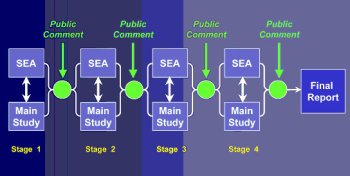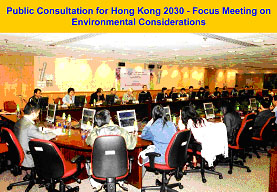|
Interactions with stakeholders is in line with the spirit of free press and freedom of information enshrined in Hong Kong’s Basic Law and is becoming an important step in a SEA. Project proponents should take initiative to communicate with their stakeholders in an attempt to achieve a “win-win” situation.
Project proponents should well communicate with relevant environmental authorities so as to improve the quality, accuracy, and adequacy of the SEA before being finalized and for the sake of effectiveness and efficiency, early communications at all possible stages with all levels are essential. To facilitate interactions with stakeholders, objective documentation of SEA findings is crucial. As the SEA process is equally important, the entire evaluation should be documented in addition to the final SEA recommendations. SEA analysis and results must be presented and able to be discussed at multi-constituency levels with people from different backgrounds. For those SEA categorized as Schedule 3 projects under the EIA Ordinance, interactions with stakeholders and members of the public have to be made during the mandatory public consultation period during which EIA reports would make available for public inspection and comments. To facilitate a fruitful and informed public consultation, environmental information of the PPPs should be provided in an user-friendly style easily understood by the public. For other SEA projects, interactions with stakeholders should be conducted in a form of intra-departmental consultations following relevant Technical Circulars, administrative procedures and guidelines. The setting up of the Advisory Council on Environment (ACE) also helps enhance the interactions as any SEA selected for submissions to ACE would be considered and discussed thoughtfully by ACE or its sub-committee members before giving advice to DEP for consideration in endorsing the SEA reports.
https://www.pland.gov.hk/pland_en/p_study/comp_s/hk2030plus/index.htm
The study performs a good practice in which SEA was designed to be interlocked with the main study and both are subject to various stages of public consultation.
| |
(click to enlarge)

|
| |
Figure 15 - SEA process interlocking with the main study in HK2030 : Planning Vision and Strategy
|
Public involvements were conducted in many ways were conducted in many ways which include view sharing workshops involving specialist advisors, community group, major stakeholders and community groups. Besides, interim and final SEA reports were made public on internet throughout the whole SEA process.
| |

|
| |
Figure 16 - Wide public consultation in HK2030 : Planning Vision and Strategy
|
View Sharing Workshops in HK 2030 : Planning Vision and Strategy – Key Points
- View Sharing Workshop focusing on environmental friendly options to be incorporated in the strategy.
- Stakeholders as specialist advisors to the Environmental Study Management Group.
- Major stakeholders :
- ACE members
- professional institute
- academics
- business sector
- Community groups
Activities during each public consultation stage in HK 2030 : Planning Vision and Strategy
- Press Conference
- Public Forum
- Roving Exhibitions
- Prizes Presentation to Design Winners
- Briefings to Statutory / Advisory / Students
- Focus Group Meetings / Workshops
| |
“The Magic of Dialogue: Transforming Conflict into Cooperation”
by Daniel Yankelovich
|
|
| |
|
|
| |
|
Debate
|
Dialogue
|
| Assuming that there is a right answer and you have it |
Assuming that many people have pieces of answer and that together they can craft a solution |
| About winning |
About exploring common ground |
| Listening to find flaws and make counter-arguments |
Listening to understand, find meaning and agreement |
| Defending assumptions as truth |
Revealing assumptions for re-evaluation |
| Seek a conclusion that ratifies your position |
Discover new options, not seeking closure |
|
|
|

